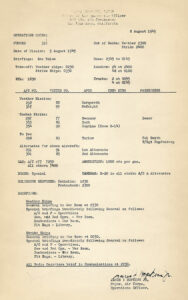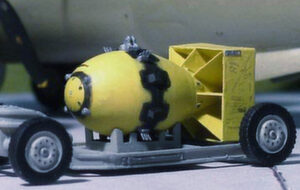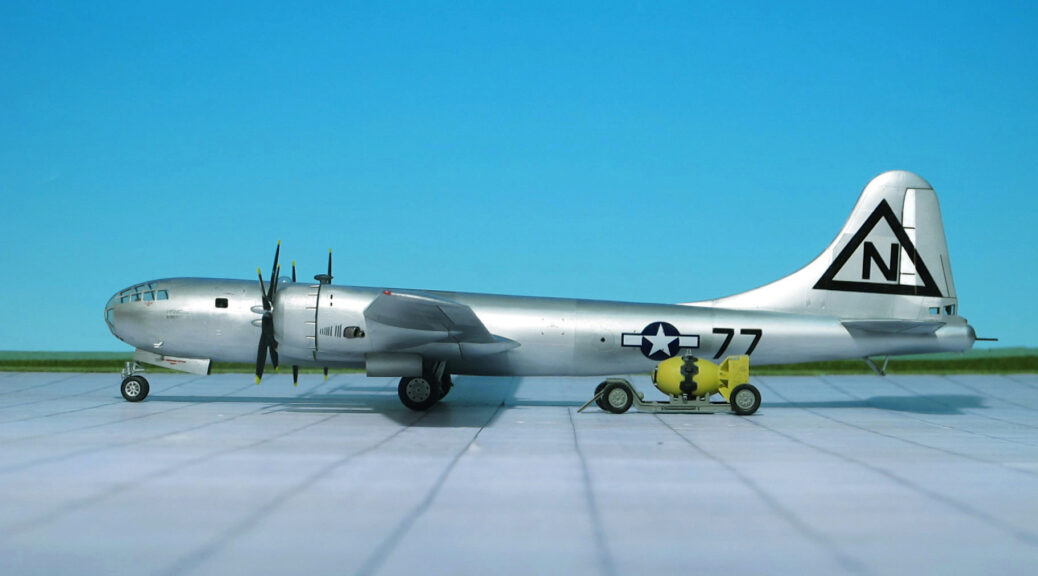STRIKE ORDER # 39
On 8 August 1945, the Strike Order # 39 was given to deliver the second atomic bomb Fat Man the next day on 9 August. This order gives the detailed time scale of the pre-flight preparations and all aircraft involved in the attack as well as the names of the aircraft‘s commanding officers. This time the combat strike consisted of three aircraft, one alternative plane stationed at Iwo Iima to take over the atomic bomb in case of failures of Bockscar and two weather mission aircraft including the Enola Gay latter flown by Captain George W. Marquardt plus two alternative aircraft . Weather Ships had to start at 0230 ET, while the strike Ships followed one hour later. Victor # 77 was the Bockscar with Major Sweeney at the controlls.. The Bombload simply mentioned „Special“, primary target was Nagasaki.

ATOMIC BOMB “FAT MAN”
“Fat Man” was 3.4 m, in length, 1.5 m in diameter and weighed 9,100 kg. The design was an implosion-type weapon using plutonium. A subcritical sphere of plutonium was placed in the center of a hollow sphere of high explosive. Numerous detonators located on the surface of the sphere were fired simultaneously to produce a powerful inward pressure on the capsule, squeezing it and increasing its density. This resulted in a supercritical condition and a nuclear explosion.
The bomb had an explosive force of about 20,000 tons of TNT, about the same as the bomb dropped on Hiroshima. Because of Nagasaki’s hilly terrain, however, the damage was somewhat less extensive than of the relatively flat Hiroshima
Three Fat Man high explosive pre-assemblies designated F31, F32, and F33 were transported to North Field, arriving 2 August. F33 was expended during the final rehearsal on 8 August, and F31 was the bomb dropped on Nagasaki. F32 presumably would have been used for a third attack or its rehearsal.

STRIKE ON NAGASAKI, DATE: AUGUST, 9th, 1945
On 1 August the aircraft was given the triangle N tail markings of the 444th Bombardment Group as a security measure, and had its Victor number changed to # 77 to avoid misidentification with an actual 444th aircraft. Except for Enola Gay, none of the 509th Composite Group B-29s had yet had names or nose art painted on the noses. All other names were given or painted after the mission.
The mission included three B-29 bombers and their crews: # 77 Bockscar, # 89 The Great Artiste and # 50 The Big Stink. Bockscar was flown on 9 August 1945 by Crew C-15, which usually manned The Great Artiste; piloted by Major Charles W. Sweeney, commander of the 393rd Bombardment Squadron; and co-piloted by First Lieutenant Charles Donald Albury, C-15’s aircraft commander. The Great Artiste – flown by Captain Frederick C. Bock – was designated as an observation and instrumentation support plane for the second mission, while The Big Stink – flown by group operations officer Major James I. Hopkins Jr. – as a photographic aircraft. The primary target was the city of Kokura, where the Kokura Arsenal was located, and the secondary target was Nagasaki, where two large Mitsubishi armament plants were located.
Bockscar had been flown by Sweeney and crew C-15 in three test drop rehearsals with inert pumpkin bomb assemblies in the eight days leading up to the second mission, including a final rehearsal the day before. The Great Artiste, which was the assigned aircraft of the crew with whom Sweeney usually flew, had been designated in preliminary planning to drop the second bomb, but the aircraft had been fitted with observation instruments for the Hiroshima mission that took place three days earlier. Moving the instrumentation from The Great Artiste to Bockscar would have been a complex and time-consuming process, and when the second atomic bomb mission was moved up from 11 to 9 August because of adverse weather forecasts, the crews of The Great Artiste and Bockscar instead changed aircraft. The result was that the bomb was carried by Bockscar but flown by the crew C-15 of The Great Artiste.
During pre-flight inspection of Bockscar, the flight engineer notified Sweeney that an inoperative fuel transfer pump made it impossible to use 640 US gallons of fuel carried in a reserve tank. This fuel would still have to be carried all the way to Japan and back, consuming still more fuel. Replacing the pump would take hours; moving the Fat Man to another aircraft might take just as long and was dangerous as well, as the bomb was live. Group Commander Colonel Paul Tibbets and Sweeney therefore elected to have Bockscar continue the mission.
Bockscar took off from Tinian’s North Field at 03:49. The mission profile directed the B-29s to fly individually to the rendezvous point, changed because of bad weather from Iwo Jima to Yakushima Island, and at 17,000 feet cruising altitude instead of the customary 9,000 feet , increasing fuel consumption. Bockscar began its climb to the 30,000 feet bombing altitude a half-hour before rendezvous. Before the mission, Tibbets had warned Sweeney to take no more than fifteen minutes at the rendezvous before proceeding to the target. Bockscar reached the rendezvous point and assembled with The Great Artiste, but after circling for some time, The Big Stink failed to appear. As they orbited Yakushima, the weather planes Enola Gay (which had dropped the first atomic bomb on Hiroshima) and Laggin‘ Dragon reported both Kokura and Nagasaki within the accepted parameters for the required visual attack.
Though ordered not to circle longer than fifteen minutes, Sweeney continued to wait for The Big Stink, finally proceeding to the target only at the urging of Commander Frederich Ashworth, the plane’s weaponeer, who was in command of the mission. After exceeding the original departure time limit by a half-hour, Bockscar, accompanied by the instrument airplane,The Great Artiste, arrived over Kokura, thirty minutes away. The delay at the rendezvous had resulted in clouds and drifting smoke from fires started by a major firebombing raid by 224 B-29s on nearby Yahata the previous day covering 70% of the area over Kokura, obscuring the aiming point. Three bomb runs were made over the next 50 minutes, burning fuel and exposing the aircraft repeatedly to the heavy defenses of Yahata, but the bombardier was unable to drop visually. By the time of the third bomb run, Japanese anti-aircraft fire was getting close, and First Lieutenant Jacob Beser, who was monitoring Japanese communications, reported activity on the Japanese fighter direction radio bands.
The increasingly critical fuel shortage resulted in the decision by Sweeney and Ashworth to reduce power to conserve fuel and divert to the secondary target, Nagasaki. The approach to Nagasaki twenty minutes later indicated that the heart of the city’s downtown was also covered by dense cloud. Ashworth decided to bomb Nagasaki using radar, but, according to Bockscar’s bombardier, Captain Kermit Beahan, a small opening in the clouds at the end of the three-minute bomb run permitted him to identify target features. Bockscar visually dropped the Fat Man at 10:58 local time. It exploded 43 seconds later with a blast yield equivalent to 21 kilotons of TNT at an altitude of 1,650 feet, approximately 1.5 miles northwest of the planned aiming point, resulting in the destruction of 44% of the city
The failure to drop the Fat Man at the precise bomb aim point caused the atomic blast to be confined to the Urakami Valley. As a consequence, a major portion of the city was protected by the intervening hills, but even so, the bomb was dropped over the city’s industrial valley midway between the Mitsubishi Steel and Arms Works in the south and the Mitsubishi-Urakami Ordnance Works in the north.
Because of the delays in the mission and the inoperative fuel transfer pump, the B-29 did not have sufficient fuel to reach the emergency landing field at Iwo Jima, so Sweeney flew the aircraft to Okinawa Arriving there, he circled for 20 minutes trying to contact the control tower for landing clearance, finally concluding that his radio was faulty. Critically low on fuel, Bockscar barely made it to the runway at Yontan Airfield on Okinawa. With only enough fuel for one landing attempt, Sweeney and Albury brought Bockscar in at 150 miles per hour instead of the normal 120 miles per hour firing distress flares to alert the field of the uncleared landing. The number two engine died from fuel starvation as Bockscar began its final approach. Touching the runway hard, the heavy B-29 slewed left and towards a row of parked Consolidated B-24 Liberator bombers before the pilots managed to regain control. The B-29’s reversible propellers were insufficient to slow the aircraft adequately, and with both pilots standing on the brakes, Bockscar made a swerving 90-degree turn at the end of the runway to avoid running off the runway. A second engine died from fuel exhaustion by the time the plane came to a stop. The flight engineer later measured fuel in the tanks and concluded that less than five minutes total remained (Ref.: 24).









